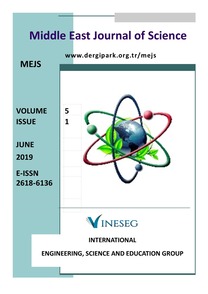A HYBRID MULTI-CRITERIA DECISION MAKING METHOD FOR ROBOT SELECTION IN FLEXIBLE MANUFACTURING SYSTEM
Robot Selection, MCDM Model CRITIC Model, MABAC Method, VIKOR,
___
- [1] R. Kumar and R. K. Garg, “Optimal selection of robots by using distance based approach method,” Robotics and Computer-Integrated Manufacturing, vol. 26, no. 5, pp. 500–506, Oct. 2010, doi: 10.1016/j.rcim.2010.03.012.
- [2] R. V. Rao, B. K. Patel, and M. Parnichkun, “Industrial robot selection using a novel decision making method considering objective and subjective preferences,” Robotics and Autonomous Systems, vol. 59, no. 6, pp. 367–375, Jun. 2011, doi: 10.1016/j.robot.2011.01.005.
- [3] D. E. Koulouriotis and M. K. Ketipi, “Robot evaluation and selection Part A: an integrated review and annotated taxonomy,” Int J Adv Manuf Technol, vol. 71, no. 5–8, pp. 1371–1394, Mar. 2014, doi: 10.1007/s00170-013-5525-5.
- [4] M. K. Ketipi, D. E. Koulouriotis, and E. G. Karakasis, “Robot evaluation and selection Part B: a comparative analysis,” Int J Adv Manuf Technol, vol. 71, no. 5–8, pp. 1395–1417, Mar. 2014, doi: 10.1007/s00170-013-5526-4.
- [5] P. P. Bhangale, V. P. Agrawal, and S. K. Saha, “Attribute based specification, comparison and selection of a robot,” Mechanism and Machine Theory, vol. 39, no. 12, pp. 1345–1366, Dec. 2004, doi: 10.1016/j.mechmachtheory.2004.05.020.
- [6] P. Chatterjee, V. Manikrao Athawale, and S. Chakraborty, “Selection of industrial robots using compromise ranking and outranking methods,” Robotics and Computer-Integrated Manufacturing, vol. 26, no. 5, pp. 483–489, Oct. 2010, doi: 10.1016/j.rcim.2010.03.007.
- [7] A. Kentli and A. K. Kar, “A satisfaction function and distance measure based multi-criteria robot selection procedure,” International Journal of Production Research, vol. 49, no. 19, pp. 5821–5832, Oct. 2011, doi: 10.1080/00207543.2010.530623.
- [8] Y. Fu, M. Li, H. Luo, and G. Q. Huang, “Industrial robot selection using stochastic multicriteria acceptability analysis for group decision making,” Robotics and Autonomous Systems, vol. 122, p. 103304, Dec. 2019, doi: 10.1016/j.robot.2019.103304.
- [9] D. Diakoulaki, G. Mavrotas, and L. Papayannakis, “Determining objective weights in multiple criteria problems: The critic method,” Computers & Operations Research, vol. 22, no. 7, pp. 763–770, Aug. 1995, doi: 10.1016/0305-0548(94)00059-H.
- [10] D. I. Božanić, D. S. Pamučar, and S. M. Karović, “Application the MABAC method in support of decision-making on the use of force in a defensive operation,” Tehnika, vol. 71, no. 1, pp. 129–136, 2016.
- [11] D. Pamučar, Ž. Stević, and E. K. Zavadskas, “Integration of interval rough AHP and interval rough MABAC methods for evaluating university web pages,” Applied Soft Computing, vol. 67, pp. 141–163, 2018.
- [12] D. Pamučar and G. Ćirović, “The selection of transport and handling resources in logistics centers using Multi-Attributive Border Approximation area Comparison (MABAC),” Expert systems with applications, vol. 42, no. 6, pp. 3016–3028, 2015.
- [13] Wakeel, S., Bingol, S., Bashir, M. N., & Ahmad, S. (2020). Selection of sustainable material for the manufacturing of complex automotive products using a new hybrid Goal Programming Model for Best Worst Method–Proximity Indexed Value method. Proceedings of the Institution of Mechanical Engineers, Part L: Journal of Materials: Design and Applications, 1464420720966347.
- [14] Wakeel, S., Ahmad, S., Bingol, S., Bashir, M. N., Paçal, T. C., & Khan, Z. A. (2020, August). Supplier Selection for High Temperature Die Attach by hybrid Entropy-Range of Value MCDM Technique: A Semiconductor Industry. In 2020 21st International Conference on Electronic Packaging Technology (ICEPT) (pp. 1-5). IEEE
- ISSN: 2618-6136
- Yayın Aralığı: 2
- Başlangıç: 2015
- Yayıncı: -
Shafi AHMAD, Sedat BİNGÖL, Saif WAKEEL
SERAP KILIÇ ALTUN, Mehmet Emin AYDEMİR
Alevcan KAPLAN, Umut ÇELİKOĞLU
COMPARATIVE ASSESSMENT OF DOSE CALIBRATORS USED IN NUCLEAR MEDICINE
Merve CİNOĞLU KARACA, Duygu TUNÇMAN GENÇ, Hatice KOVAN, Mehmet MÜLAZIMOĞLU, Bayram DEMİR
Cenk YANEN, Ercan AYDOĞMUŞ, MURAT YAVUZ SOLMAZ
COMPARATIVE ASSESMENT OF DOSE CALIBRATORS USED IN NUCLEAR MEDICINE
Merve CİNOĞLU KARACA, Duygu TUNÇMAN GENÇ, Hatice KOVAN, Mehmet MÜLAZIMOĞLU, Bayram DEMİR
DETERMINATION OF SUITABLE RHEOLOGICAL MODEL FOR POLYETHYLENE GLYCOLS AND SILICA PARTICLE MIXTURES
